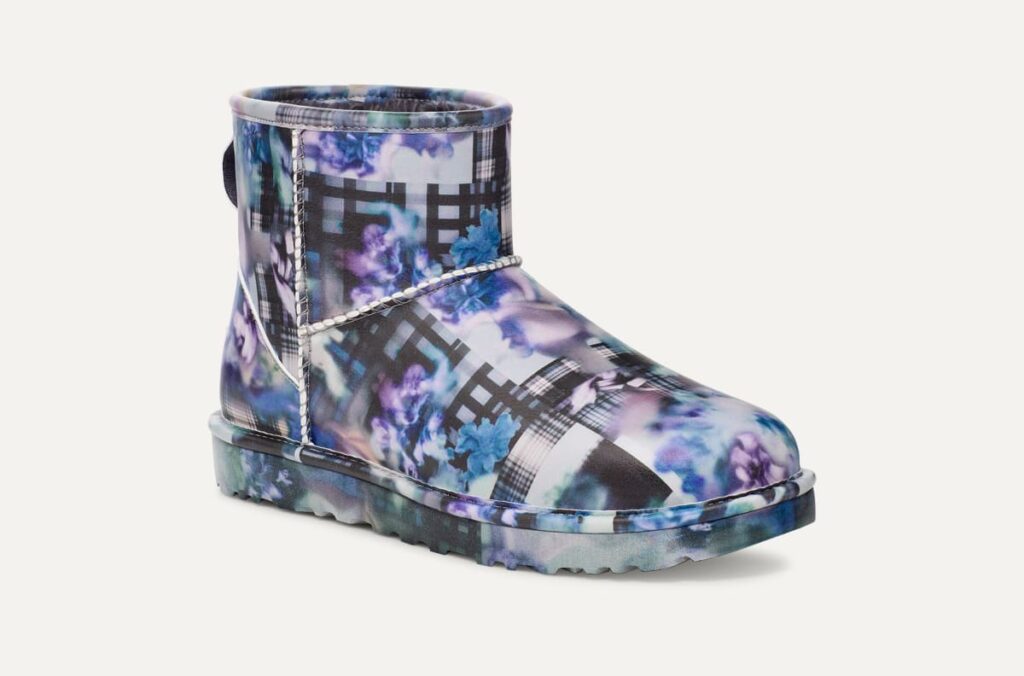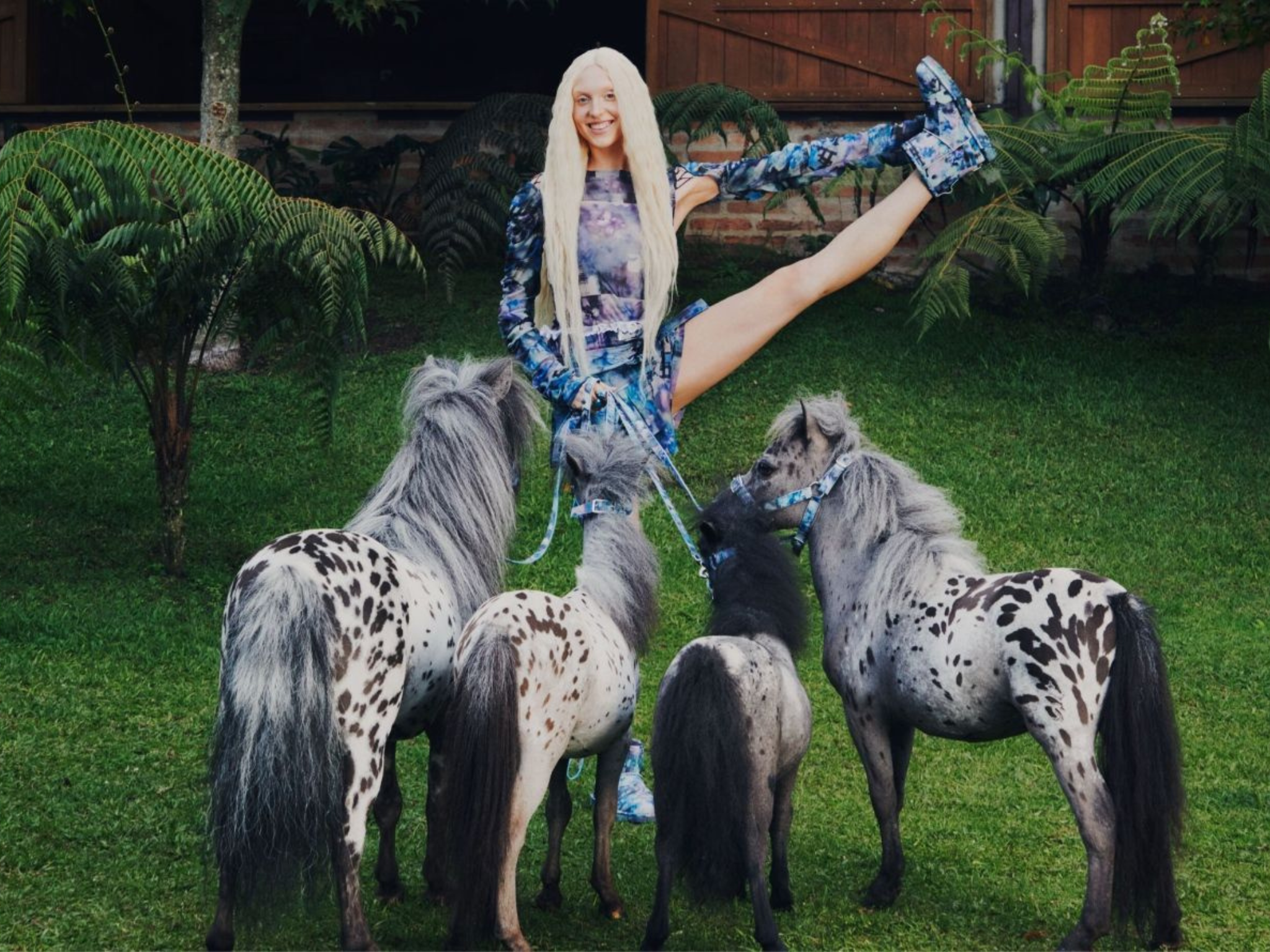Vegan Uggs Are A Step Forward for Animal Rights, But Are They Truly Sustainable?
5 Mins Read
Uggs has released a long-awaited line of vegan shoes and socks with New York’s Collina Strada but as with many animal-free alternatives to conventional materials, the plastic waste cost remains high.
After years of calls from consumers and animal welfare activists, Australian sheepskin boot maker Ugg finally introduced a vegan line of its famous shoes last month, though notably, while Collina Strada markets them as vegan, Uggs has mostly resisted using the label.
In collaboration with Hillary Taymour’s fashion label Collina Strada, the lineup comprises six shoes – from Ruffle Boots to Mini Platforms – as well as thigh-high socks. They’re available in the UK, with the shoes ranging from £180 to £230, and the socks retailing at £45. (Editor’s Note: The collection has since been spotted in the US and one reader saw some in Taipei so it appears they are available in multiple countries).
Instead of using animal-derived components like sheepskin and leather, the shoes are made from what the company describes as ‘plant-based ingredients’.
But while the animal-free footwear is a major win for animal rights – the move was hailed by Peta too – there’s still some way to go in terms of sustainability, particularly when it comes to what plastic waste activists term ‘end of life’.
Vegan Uggs a positive sign, but not without their own problems

Ugg touts a range of innovative new materials for its vegan collection. The Ruffle Boots, for example, contain vegan organza, a textile blend of recycled polyester and elastane, sugarcane EVA (a rubber-like polymer), and a synthetic coating made from 52% plant-based materials and recycled microfibre.
Meanwhile, the Classic Mini Uggs have a Tencel-based faux fur (mixed with recycled polyester), sugarcane EVA, and the same synthetic coating, and the Thigh High socks are 97% polyester (not recycled, according to the brand’s website) and 3% elastane.
According to the material’s manufacturers, sugarcane-based EVA can be composted, recycled or reused in the same cycle as fossil-based EVA. All that sounds great. The problem? Compost facilities are few and far between in most countries, recycling infrastructure is patchy and most consumers aren’t aware of where to dispose of old shoes (other than a second-hand store). Further, while the sugarcane EVA on its own can theoretically be degraded, once it’s mixed with other materials, as in this case, it becomes pretty much impossible to recycle (or compost).
Elastane, which is made from polyurethane (a type of fossil-fuel-based plastic), can be key for textile stretchability and durability— it’s what makes your yoga pants stretchy— but comes at a cost for the planet. Making elastane is an energy-intensive, highly polluting production process, and for all its functional attributes, elastane is non-degradable, remaining in the environment for hundreds of years (unless it is burned).
Then there’s recycled polyester (rPET), a “reuse” upgrade to one of the most commonly used plastic materials globally. It is made by melting existing plastic (usually bottles) and re-spinning it into fibre. From a waste diversion point of view, recycling plastic can be seen as a positive solution. From a circular economy point of view, the reality is more murky. rPET may be recycled, but it’s still plastic. And plastic, which is made from fossil fuels, is full of toxins and sheds microplastics, microplastics, which harm both marine life and human health.
While we’d all like to believe recycling is the answer to our plastic woes, in actuality, it’s a complex topic. The vast majority of all plastic ever created will never be recycled. Recycling levels max out at just under 10% (that’s right, 10%) globally, and in most countries, recycling just isn’t working. Over 90% of all plastic is either incinerated (a.k.a. burnt, a process that results in air pollution and health problems for those who live around incineration facilities) or (to a much larger extent) landfilled. Further, it’s tough enough to recycle mono-material products made from PET, but since there’s no way to separate materials like sugarcane-based EVA from elastane and the like, multi-material/blended material products like these will end up either in an incinerator or a landfill, neither of which leads us towards a more circular world.
Uggs efforts are laudable and it’s great to see fashion brands innovating on inputs. But we need to raise the bar and get to a point where both material inputs AND end of life are equally valued when it comes to the design process. Waste, even if it’s ‘better-for-you’ waste or lower-carbon waste, is still waste.
Finding the balance

Ugg isn’t the only brand to come out with a vegan shoe of late, with Adidas, Louis Vuitton, New Balance, Puma and Allbirds all coming out with animal-free products and ranges in recent years. Ugg itself released a Plant Power line in 2021, which had shoes made from what it claimed were carbon-neutral and plant-based materials.
Such efforts are inarguably important for animal welfare. “Ugg’s new vegan boots are a step in the right direction that will help spare gentle sheep being pinned down and often cut and hit so that humans can steal the wool that belongs to them,” Peta’s executive VP Tracy Reiman said about the Collina Strada range.
But the animal rights charity also pointed to the horrific welfare standards at Australian wool industry farms to urge Uggs to ditch shearling altogether. These calls don’t always go unheeded – in 2022, Ugg’s parent company Deckers Brands said it would eliminate the use of alpaca wool.
However, all this raises a conundrum for the aparrel industry and ethically-minded fashionistas: when it comes to vegan products, how do you balance animal rights with the environment? We’re still using plastic – recycled or otherwise – that can end up in landfill, so this solution isn’t a complete win-win.
A third of all plastic waste ends up in soil or freshwater, disintegrating into microplastics that have already been discovered in the human body – one study estimates that we eat 5g of microplastics per week on average (about the same as eating a credit card’s worth of plastic).
How the industry deals with the issue is crucial to its – and the planet’s – future. Animal rights and environmental sustainability should go hand-in-hand, and not come at the expense of the other.



